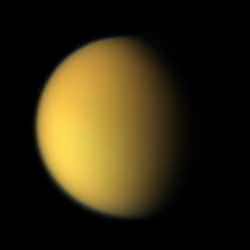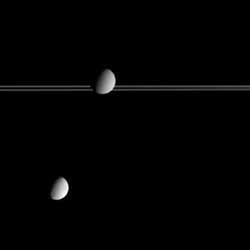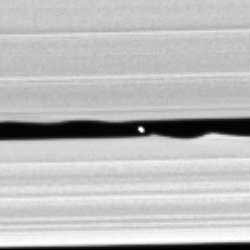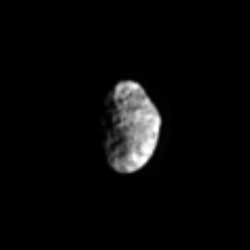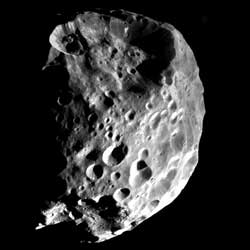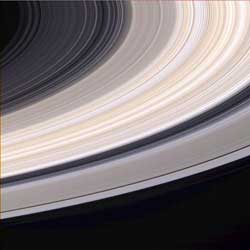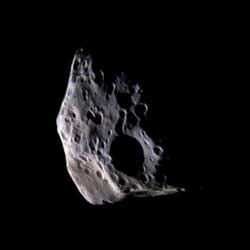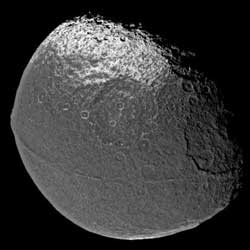
Saturn’s moon Iapetus and its strange “rindge”. Image credit: NASA/JPL/SSI. Click to enlarge.
Is there any more mysterious and beautiful planet for the observer than Saturn? While all four gas giants in our solar system have a ring system, only Saturn’s can be seen from Earth. Backyard astronomers have long been thrilled to witness its two bright rings and the dark Cassini division, while observatory telescopes have identified many separate rings and gaps. Not until the beginning of the 1980’s when Voyager made it’s “fly-by” were we aware of more than a thousand individual rings bound by the gravity of Saturn and its many small moons. The rings themselves are nothing more than icy particles ranging in size from dust motes to boulders. Joining in this intricate dance are the satellites – from Mercury-sized atmospheric Titan to tumbling, eccentrically orbiting Hyperion. Since the late 18th century we have known of Titan, Mimas, Enceladus, Tethys, Dione, Rhea and Iapetus. Our studies have revealed that four of the moons play a key role in shaping Saturn’s ring system – Pan, Atas, Pandora and Prometheus. We know that Enceladus’ highly reflective surface is comprised of ice and that Iapetus is much brighter one one side than the other…
And may have collected a ring as it swept through orbital changes.
From the time of its discovery in 1672, we have been aware the leading hemisphere of Iapetus is fully a magnitude darker than the trailing side. Thanks to the Cassini mission’s images taken in December 2004, the presence of a large equatorial ridge has been discovered on Iapetus’ dark side.
According to a Geophysical Research Letter submitted on the 29th of April by Paulo C.C. Freire of Arecibo Observatory, “…this ridge and the dark coating of the hemisphere on which it lies are intimately interlinked and are the result of a collision with the edge of a primordial Saturnian ring, ultimately caused by a sudden change in the orbit of Iapetus”. Says Freire, “Because of its unique nature, we will henceforth refer to the equatorial ridge of Iapetus simply as ‘the Rindge’ to mean that this feature is not a ridge in the usual sense of the term; i.e., a mountain chain caused by tectonic process. This model naturally explains all of the unique features of this satellite; and is probably the solution to one of the oldest mysteries in solar system astronomy.”
One of the scientific goals of the Cassini fly-by imaging was to shed some light on Iapetus’ dark side, called Cassini Regio. To the surprise of the researchers, it revealed a great equatorial ridge unlike anything else found in the solar system – a ridge so symmetrical relative to the Cassini Regio that the two features must be linked, as acknowledged previously by Carolyn Porco – head of the Cassini Imaging Team. The majority of the clues point to how the ring system and the forming moons once orbited Saturn itself.
Current understanding of the formation of the solar system (and, in a smaller scale, the Saturnian system) indicates that many planetoids (and proto-satellites) may have once started in orbits that later became unstable. They could have collided with each other, or been ejected from their system by close encounters with others. In the case of Saturn, it is possible they could have been tidally disrupted when approaching Saturn’s gravity and formed ring systems. Closer to the planet, in an area known as the “Roche Zone”, the tidal pull of Saturn prevents proto-satellite formation from ring particles. In order for the ring collision theory to match what Cassini has imaged, Iapetus had to have been one of these moons with unstable orbits.
Evidence points to the fact that something changed Iapetus’ orbit before colliding with ring material. Had this not happened, the ring would have adjusted to Iapetus’ gravity as evidenced by satellites currently imbedded within the rings. In the case of these satellites – no collision scenario can occur. In Iapetus’ circumstance, its orbit was necessarily eccentric, or no velocity differences would exist between Iapetus and the ring particles and again – no collisions would occur.
An impact with a ring also suggests this changed orbit had a perisaturnium at the outer edge of the Roche Zone, where rings can exist for longer periods of time. This is a clue that Iapetus was quite probably much closer to Saturn than its present orbit. “The existence of the rindge suggests the orbit of Iapetus at the time of the collision was equatorial” says Freire, “otherwise, with its present inclination a collision with a ring would not produce a sharp edge, but something more like a wispy dark coating of the leading hemisphere.” In conclusion, a satellite with an equatorial and eccentric orbit has a very large probability of interacting further with other satellites – providing the means to change yet again to a different orbit.
Now that we have set the stage, how do the images taken of this unique rindge support the theory? According to Freire, “The ring collisions scenario naturally produces a linear feature exactly at the equator: this is the geometric intersection of a ring plane and the surface of a moon with a (previously) equatorial orbit.” Very careful consideration has been given to tectonics, but such a perfectly linear formation – located exactly at the equator – is unlikely to result from tectonic processes and Iapetus shows no signs of volcanic activity.
“Another key feature of the rindge is that its height varies extremely slowly with longitude,” says Freire, “This can be expected from deposition of material from a ring, but such a constant height has never been observed for any tectonic feature. If the origin of the rindge was tectonic and preceded the dark coating, then it should not necessarily be confined to Cassini Regio. If it postdated the coating, then the rindge being built from an upwelling from the interior of Iapetus should be much brighter than the surrounding surface.”
Considerable analysis has been given to the information that Cassini imaging has provided. The longitudinal length of the ridge is less than 180 degrees, which suggests that Iapetus was never fully inside the ring region – indicating that it just collided with a ring edge. Celestial mechanics considerations indicate that a collision with a ring edge should have caused an eastward motion of the particle’s impacts relative to the surface of the satellite. “This accounts for an important observed fact: although Cassini Regio is symmetrical relative to the rindge in the north/south direction, it is not so in the east/west direction.” This collision model suggests that the rindge would be taller on the western side where the impacts were closer to vertical and then would slowly digress moving eastward – a fact supported by the images. With millions of impact craters being formed every second along a line, this pattern would become unmistakable. The sublimation of the ices contained in the impacting particles would produce a transient atmosphere, with a strong pressure gradient away from the rindge. This gradient would produce fast winds capable of carrying fine dust. Says Freire, “In our hypothesis, the dust deposited by such winds is the dark coating of the region known today as Cassini Regio.” Such a scenario is supported by other evidence: “The dark streaks observed at the edge of Cassini Regio indicate that it was a wind blowing from the equator that deposited the ‘dust’. We can be certain of this because Cassini imagery shows clearly that the dust is deposited downward from the crater rims.” This can’t be accounted for by ballistic flight of the particles from the equator, as suggested by the leader of the Cassini Imaging Team, Carolyn Porco. It can’t be produced in present-day Iapetus, since it has no atmosphere. The conclusion that a transient atmosphere once existed becomes inescapable.
Could these exciting findings truly be from an earlier impact with one of Saturn’s rings? The clues certainly seem to make the pieces of the puzzle fit together neatly. Thanks to work done by researchers like Paulo Freire, we may have solved a 333 year-old solar system mystery.
Written by Tammy Plotner, with many thanks to Paulo Freire for his contributions.
